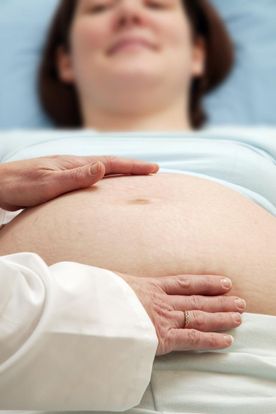36 weeks and 4 days pregnant

Your baby is now more suitably equipped for the time after birth. His ears are fully formed on the outside and inside and he is used to hearing the sound of your blood circulating and your heart beating, and he recognizes your voice.
Your baby is losing the downy hair that he’s had for several weeks, but if he’s born now there may still be some visible.
Lanugo is extremely fine hair that covers your baby’s body and, unlike adult hairs on the body, it is not associated with sweat glands. Lanugo hairs begin to be shed now as they are lost into the amniotic fluid in the last few weeks before birth. Your baby then swallows these lanugo hairs in the amniotic fluid but this is not a cause for concern: these hairs provide your baby with an important source of protein, essential to his development. It’s been estimated that two-thirds of the protein in the fluid is swallowed and absorbed by the baby’s gut each day, providing 15 per cent of his protein needs.
The fine lanugo hairs are gradually replaced by vellus hairs, which are short, soft, non-pigmented hairs (often seen more on women and children). Terminal hair is the thicker, coarser, and longer hair that first grows on your baby’s eyebrows, then his eyelashes, then his scalp. In adults, facial hair (beards), armpit, and pubic hair is terminal hair.
In the third trimester you’ll be frequenting the loo regularly, as you did in the first trimester. At this stage it’s due to the increasingly heavy baby pushing down on your bladder from above. If you find that it hurts when you expel urine, you may have a urinary infection and should contact your midwife or doctor for a test.
I’ve heard about doctors “turning” breech babies. How does this work?
Some obstetricians may try to turn a baby in late pregnancy using external cephalic version (ECV), which has a success rate of around 50 per cent. The obstetrician tries gently to guide the baby into a head-down position by pressing his hands on the mother’s abdomen, using an ultrasound as a guide. You may be given a drug to relax the uterine muscles. You will be scanned first and if the baby is in an awkward position the procedure may not continue. If your baby is large this can affect the procedure, as can the amount of amniotic fluid: a low amount of fluid offers less protection to the baby.
If you’re rhesus negative, you will have an anti-D injection after the ECV because of a small risk of a bleed around the placenta. An ECV is not recommended if you have a multiple pregnancy, have had bleeding, your placenta is low-lying, your membranes have ruptured, or there is a known problem with the baby.

The midwife will examine your abdomen in late pregnancy to check the position of the baby. If the baby is breech, an ECV may be recommended to turn him into a head-down position. If he doesn’t turn, a Caesarean delivery may be necessary.
Be the first to support
Be the first to share
Comment (0)
Related Blogs & Vlogs
No related events found.
Loading more...